Comprehensive Brand Management Analysis: Tesco PLC - Report
VerifiedAdded on 2023/01/19
|21
|6909
|40
Report
AI Summary
This report provides a comprehensive analysis of brand management, using Tesco PLC as a case study. It begins by defining brand management and its importance, exploring concepts such as brand equity, brand strategy, and the significance of branding to businesses, customers, and intermediaries. The report then delves into the building and management of brands over time, including brand vision, values, perception, and positioning, along with the brand pyramid framework and strategies for improving brand equity like brand crisis, extension, reinforcement and revitalization. Furthermore, the report examines brand portfolio strategy, including branded house and house of brands approaches. Finally, it explores brand extension and leveraging, and methods for measuring brand value. Overall, the report offers valuable insights into the key elements of effective brand management and its practical application within the retail industry, using Tesco PLC as an example.

BRAND MANAGEMENT
Paraphrase This Document
Need a fresh take? Get an instant paraphrase of this document with our AI Paraphraser
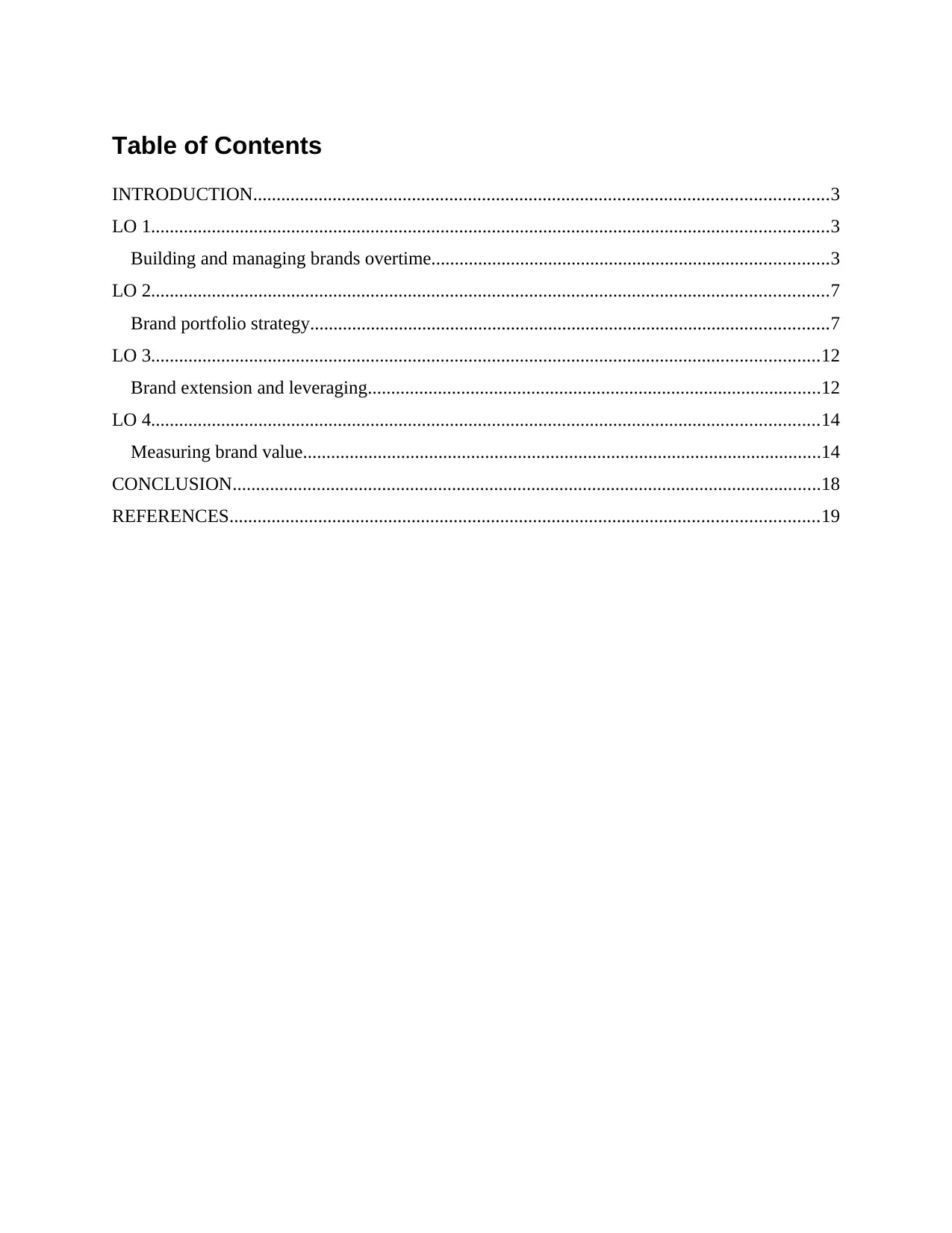
Table of Contents
INTRODUCTION...........................................................................................................................3
LO 1.................................................................................................................................................3
Building and managing brands overtime.....................................................................................3
LO 2.................................................................................................................................................7
Brand portfolio strategy...............................................................................................................7
LO 3...............................................................................................................................................12
Brand extension and leveraging.................................................................................................12
LO 4...............................................................................................................................................14
Measuring brand value...............................................................................................................14
CONCLUSION..............................................................................................................................18
REFERENCES..............................................................................................................................19
INTRODUCTION...........................................................................................................................3
LO 1.................................................................................................................................................3
Building and managing brands overtime.....................................................................................3
LO 2.................................................................................................................................................7
Brand portfolio strategy...............................................................................................................7
LO 3...............................................................................................................................................12
Brand extension and leveraging.................................................................................................12
LO 4...............................................................................................................................................14
Measuring brand value...............................................................................................................14
CONCLUSION..............................................................................................................................18
REFERENCES..............................................................................................................................19
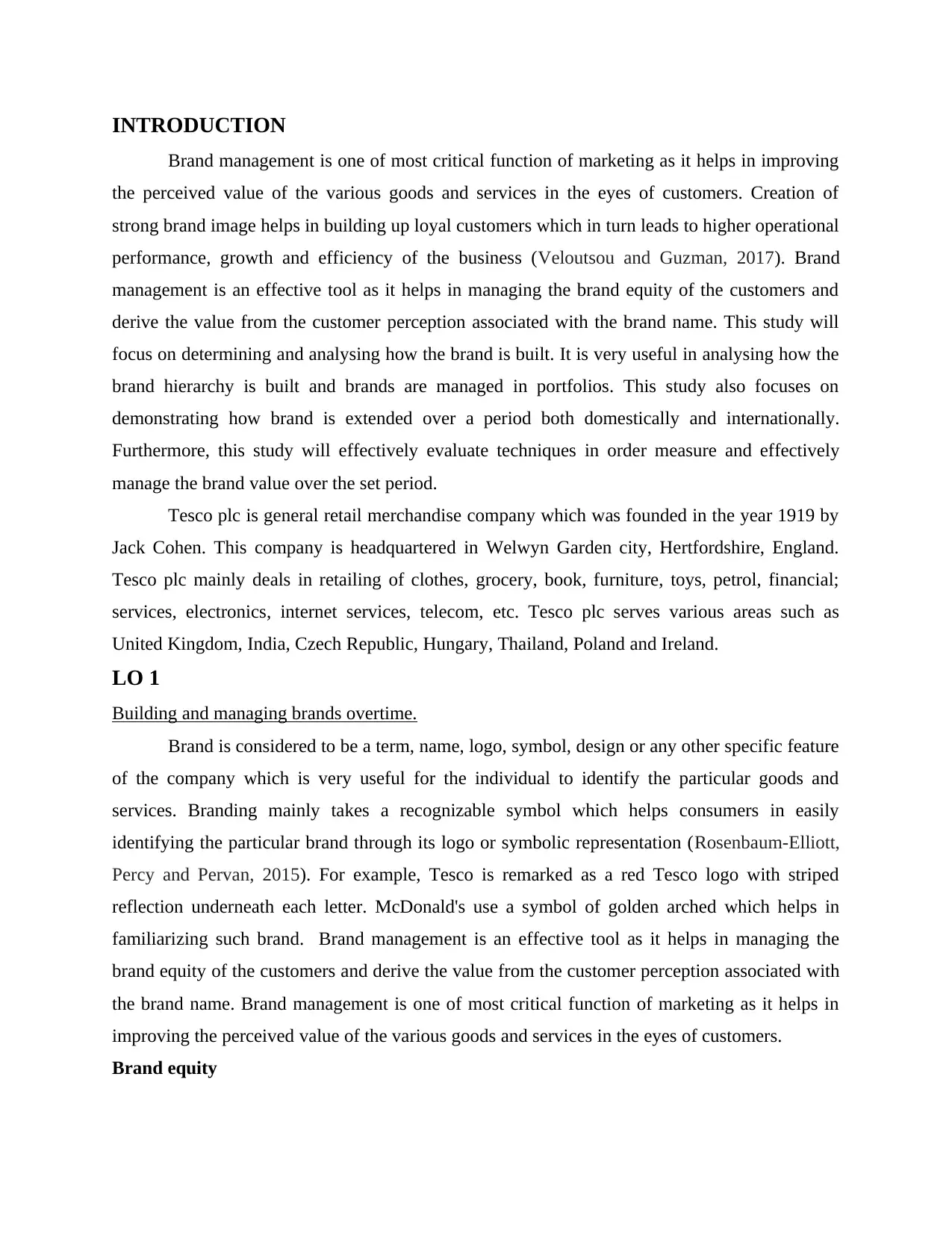
INTRODUCTION
Brand management is one of most critical function of marketing as it helps in improving
the perceived value of the various goods and services in the eyes of customers. Creation of
strong brand image helps in building up loyal customers which in turn leads to higher operational
performance, growth and efficiency of the business (Veloutsou and Guzman, 2017). Brand
management is an effective tool as it helps in managing the brand equity of the customers and
derive the value from the customer perception associated with the brand name. This study will
focus on determining and analysing how the brand is built. It is very useful in analysing how the
brand hierarchy is built and brands are managed in portfolios. This study also focuses on
demonstrating how brand is extended over a period both domestically and internationally.
Furthermore, this study will effectively evaluate techniques in order measure and effectively
manage the brand value over the set period.
Tesco plc is general retail merchandise company which was founded in the year 1919 by
Jack Cohen. This company is headquartered in Welwyn Garden city, Hertfordshire, England.
Tesco plc mainly deals in retailing of clothes, grocery, book, furniture, toys, petrol, financial;
services, electronics, internet services, telecom, etc. Tesco plc serves various areas such as
United Kingdom, India, Czech Republic, Hungary, Thailand, Poland and Ireland.
LO 1
Building and managing brands overtime.
Brand is considered to be a term, name, logo, symbol, design or any other specific feature
of the company which is very useful for the individual to identify the particular goods and
services. Branding mainly takes a recognizable symbol which helps consumers in easily
identifying the particular brand through its logo or symbolic representation (Rosenbaum-Elliott,
Percy and Pervan, 2015). For example, Tesco is remarked as a red Tesco logo with striped
reflection underneath each letter. McDonald's use a symbol of golden arched which helps in
familiarizing such brand. Brand management is an effective tool as it helps in managing the
brand equity of the customers and derive the value from the customer perception associated with
the brand name. Brand management is one of most critical function of marketing as it helps in
improving the perceived value of the various goods and services in the eyes of customers.
Brand equity
Brand management is one of most critical function of marketing as it helps in improving
the perceived value of the various goods and services in the eyes of customers. Creation of
strong brand image helps in building up loyal customers which in turn leads to higher operational
performance, growth and efficiency of the business (Veloutsou and Guzman, 2017). Brand
management is an effective tool as it helps in managing the brand equity of the customers and
derive the value from the customer perception associated with the brand name. This study will
focus on determining and analysing how the brand is built. It is very useful in analysing how the
brand hierarchy is built and brands are managed in portfolios. This study also focuses on
demonstrating how brand is extended over a period both domestically and internationally.
Furthermore, this study will effectively evaluate techniques in order measure and effectively
manage the brand value over the set period.
Tesco plc is general retail merchandise company which was founded in the year 1919 by
Jack Cohen. This company is headquartered in Welwyn Garden city, Hertfordshire, England.
Tesco plc mainly deals in retailing of clothes, grocery, book, furniture, toys, petrol, financial;
services, electronics, internet services, telecom, etc. Tesco plc serves various areas such as
United Kingdom, India, Czech Republic, Hungary, Thailand, Poland and Ireland.
LO 1
Building and managing brands overtime.
Brand is considered to be a term, name, logo, symbol, design or any other specific feature
of the company which is very useful for the individual to identify the particular goods and
services. Branding mainly takes a recognizable symbol which helps consumers in easily
identifying the particular brand through its logo or symbolic representation (Rosenbaum-Elliott,
Percy and Pervan, 2015). For example, Tesco is remarked as a red Tesco logo with striped
reflection underneath each letter. McDonald's use a symbol of golden arched which helps in
familiarizing such brand. Brand management is an effective tool as it helps in managing the
brand equity of the customers and derive the value from the customer perception associated with
the brand name. Brand management is one of most critical function of marketing as it helps in
improving the perceived value of the various goods and services in the eyes of customers.
Brand equity
⊘ This is a preview!⊘
Do you want full access?
Subscribe today to unlock all pages.

Trusted by 1+ million students worldwide
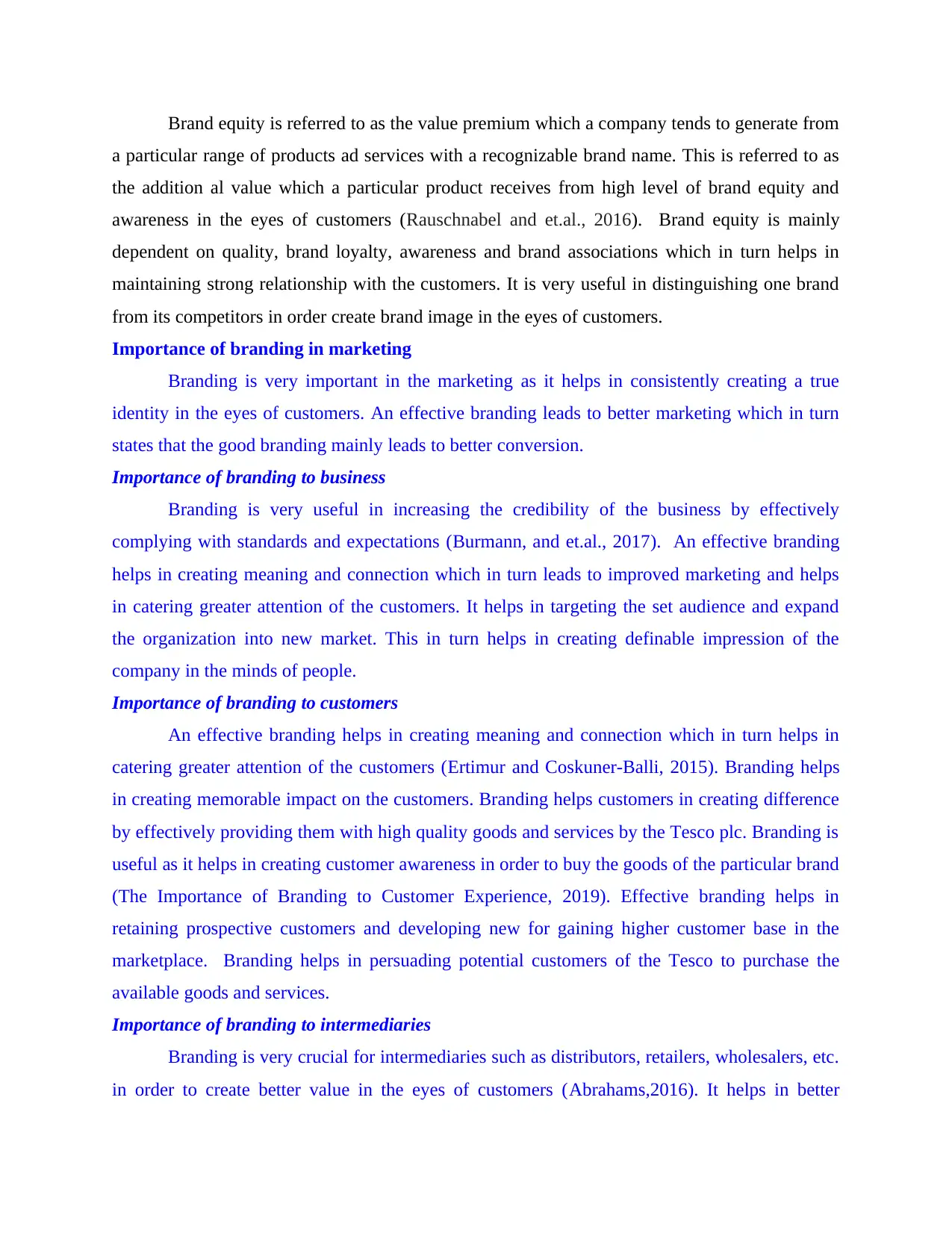
Brand equity is referred to as the value premium which a company tends to generate from
a particular range of products ad services with a recognizable brand name. This is referred to as
the addition al value which a particular product receives from high level of brand equity and
awareness in the eyes of customers (Rauschnabel and et.al., 2016). Brand equity is mainly
dependent on quality, brand loyalty, awareness and brand associations which in turn helps in
maintaining strong relationship with the customers. It is very useful in distinguishing one brand
from its competitors in order create brand image in the eyes of customers.
Importance of branding in marketing
Branding is very important in the marketing as it helps in consistently creating a true
identity in the eyes of customers. An effective branding leads to better marketing which in turn
states that the good branding mainly leads to better conversion.
Importance of branding to business
Branding is very useful in increasing the credibility of the business by effectively
complying with standards and expectations (Burmann, and et.al., 2017). An effective branding
helps in creating meaning and connection which in turn leads to improved marketing and helps
in catering greater attention of the customers. It helps in targeting the set audience and expand
the organization into new market. This in turn helps in creating definable impression of the
company in the minds of people.
Importance of branding to customers
An effective branding helps in creating meaning and connection which in turn helps in
catering greater attention of the customers (Ertimur and Coskuner-Balli, 2015). Branding helps
in creating memorable impact on the customers. Branding helps customers in creating difference
by effectively providing them with high quality goods and services by the Tesco plc. Branding is
useful as it helps in creating customer awareness in order to buy the goods of the particular brand
(The Importance of Branding to Customer Experience, 2019). Effective branding helps in
retaining prospective customers and developing new for gaining higher customer base in the
marketplace. Branding helps in persuading potential customers of the Tesco to purchase the
available goods and services.
Importance of branding to intermediaries
Branding is very crucial for intermediaries such as distributors, retailers, wholesalers, etc.
in order to create better value in the eyes of customers (Abrahams,2016). It helps in better
a particular range of products ad services with a recognizable brand name. This is referred to as
the addition al value which a particular product receives from high level of brand equity and
awareness in the eyes of customers (Rauschnabel and et.al., 2016). Brand equity is mainly
dependent on quality, brand loyalty, awareness and brand associations which in turn helps in
maintaining strong relationship with the customers. It is very useful in distinguishing one brand
from its competitors in order create brand image in the eyes of customers.
Importance of branding in marketing
Branding is very important in the marketing as it helps in consistently creating a true
identity in the eyes of customers. An effective branding leads to better marketing which in turn
states that the good branding mainly leads to better conversion.
Importance of branding to business
Branding is very useful in increasing the credibility of the business by effectively
complying with standards and expectations (Burmann, and et.al., 2017). An effective branding
helps in creating meaning and connection which in turn leads to improved marketing and helps
in catering greater attention of the customers. It helps in targeting the set audience and expand
the organization into new market. This in turn helps in creating definable impression of the
company in the minds of people.
Importance of branding to customers
An effective branding helps in creating meaning and connection which in turn helps in
catering greater attention of the customers (Ertimur and Coskuner-Balli, 2015). Branding helps
in creating memorable impact on the customers. Branding helps customers in creating difference
by effectively providing them with high quality goods and services by the Tesco plc. Branding is
useful as it helps in creating customer awareness in order to buy the goods of the particular brand
(The Importance of Branding to Customer Experience, 2019). Effective branding helps in
retaining prospective customers and developing new for gaining higher customer base in the
marketplace. Branding helps in persuading potential customers of the Tesco to purchase the
available goods and services.
Importance of branding to intermediaries
Branding is very crucial for intermediaries such as distributors, retailers, wholesalers, etc.
in order to create better value in the eyes of customers (Abrahams,2016). It helps in better
Paraphrase This Document
Need a fresh take? Get an instant paraphrase of this document with our AI Paraphraser
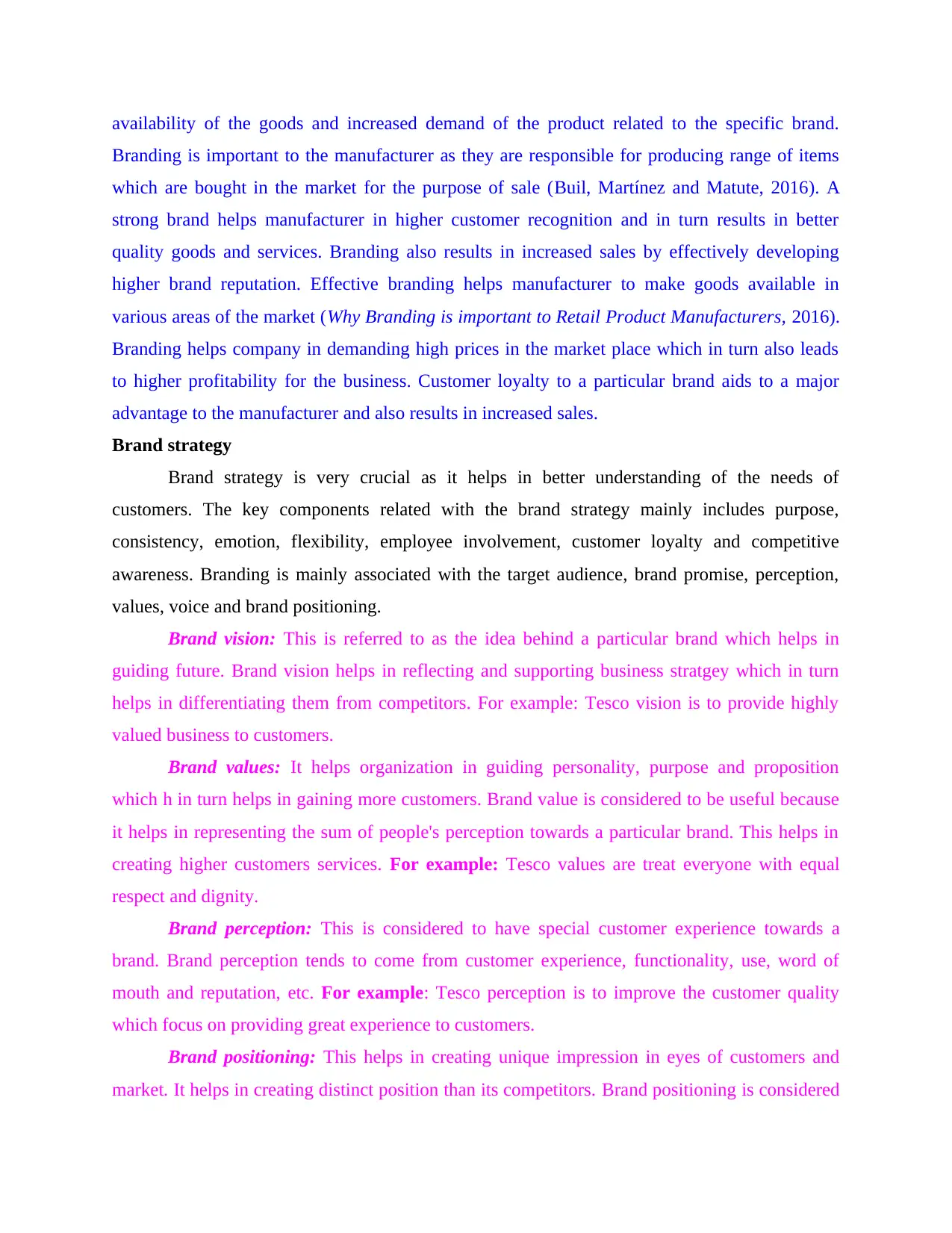
availability of the goods and increased demand of the product related to the specific brand.
Branding is important to the manufacturer as they are responsible for producing range of items
which are bought in the market for the purpose of sale (Buil, Martínez and Matute, 2016). A
strong brand helps manufacturer in higher customer recognition and in turn results in better
quality goods and services. Branding also results in increased sales by effectively developing
higher brand reputation. Effective branding helps manufacturer to make goods available in
various areas of the market (Why Branding is important to Retail Product Manufacturers, 2016).
Branding helps company in demanding high prices in the market place which in turn also leads
to higher profitability for the business. Customer loyalty to a particular brand aids to a major
advantage to the manufacturer and also results in increased sales.
Brand strategy
Brand strategy is very crucial as it helps in better understanding of the needs of
customers. The key components related with the brand strategy mainly includes purpose,
consistency, emotion, flexibility, employee involvement, customer loyalty and competitive
awareness. Branding is mainly associated with the target audience, brand promise, perception,
values, voice and brand positioning.
Brand vision: This is referred to as the idea behind a particular brand which helps in
guiding future. Brand vision helps in reflecting and supporting business stratgey which in turn
helps in differentiating them from competitors. For example: Tesco vision is to provide highly
valued business to customers.
Brand values: It helps organization in guiding personality, purpose and proposition
which h in turn helps in gaining more customers. Brand value is considered to be useful because
it helps in representing the sum of people's perception towards a particular brand. This helps in
creating higher customers services. For example: Tesco values are treat everyone with equal
respect and dignity.
Brand perception: This is considered to have special customer experience towards a
brand. Brand perception tends to come from customer experience, functionality, use, word of
mouth and reputation, etc. For example: Tesco perception is to improve the customer quality
which focus on providing great experience to customers.
Brand positioning: This helps in creating unique impression in eyes of customers and
market. It helps in creating distinct position than its competitors. Brand positioning is considered
Branding is important to the manufacturer as they are responsible for producing range of items
which are bought in the market for the purpose of sale (Buil, Martínez and Matute, 2016). A
strong brand helps manufacturer in higher customer recognition and in turn results in better
quality goods and services. Branding also results in increased sales by effectively developing
higher brand reputation. Effective branding helps manufacturer to make goods available in
various areas of the market (Why Branding is important to Retail Product Manufacturers, 2016).
Branding helps company in demanding high prices in the market place which in turn also leads
to higher profitability for the business. Customer loyalty to a particular brand aids to a major
advantage to the manufacturer and also results in increased sales.
Brand strategy
Brand strategy is very crucial as it helps in better understanding of the needs of
customers. The key components related with the brand strategy mainly includes purpose,
consistency, emotion, flexibility, employee involvement, customer loyalty and competitive
awareness. Branding is mainly associated with the target audience, brand promise, perception,
values, voice and brand positioning.
Brand vision: This is referred to as the idea behind a particular brand which helps in
guiding future. Brand vision helps in reflecting and supporting business stratgey which in turn
helps in differentiating them from competitors. For example: Tesco vision is to provide highly
valued business to customers.
Brand values: It helps organization in guiding personality, purpose and proposition
which h in turn helps in gaining more customers. Brand value is considered to be useful because
it helps in representing the sum of people's perception towards a particular brand. This helps in
creating higher customers services. For example: Tesco values are treat everyone with equal
respect and dignity.
Brand perception: This is considered to have special customer experience towards a
brand. Brand perception tends to come from customer experience, functionality, use, word of
mouth and reputation, etc. For example: Tesco perception is to improve the customer quality
which focus on providing great experience to customers.
Brand positioning: This helps in creating unique impression in eyes of customers and
market. It helps in creating distinct position than its competitors. Brand positioning is considered
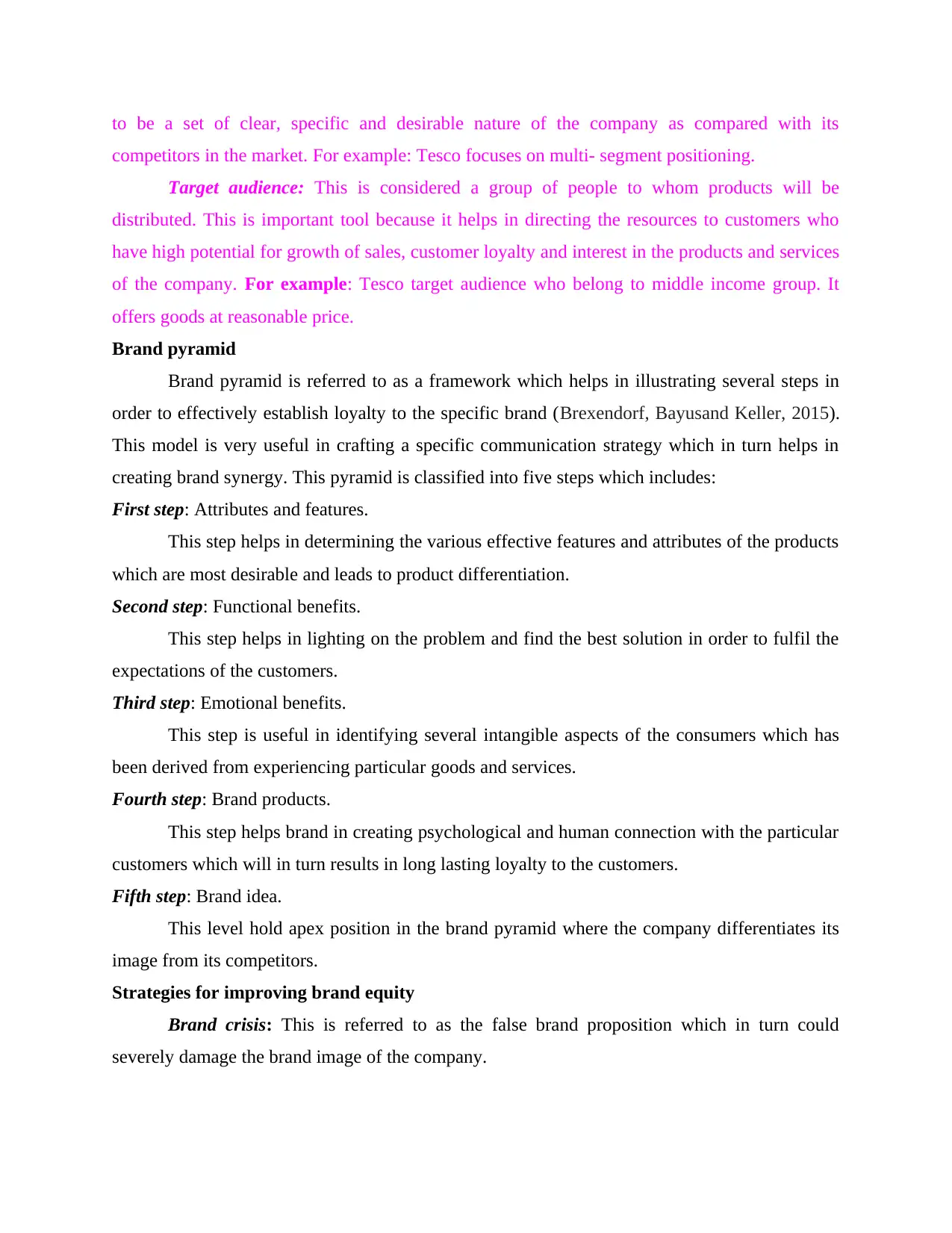
to be a set of clear, specific and desirable nature of the company as compared with its
competitors in the market. For example: Tesco focuses on multi- segment positioning.
Target audience: This is considered a group of people to whom products will be
distributed. This is important tool because it helps in directing the resources to customers who
have high potential for growth of sales, customer loyalty and interest in the products and services
of the company. For example: Tesco target audience who belong to middle income group. It
offers goods at reasonable price.
Brand pyramid
Brand pyramid is referred to as a framework which helps in illustrating several steps in
order to effectively establish loyalty to the specific brand (Brexendorf, Bayusand Keller, 2015).
This model is very useful in crafting a specific communication strategy which in turn helps in
creating brand synergy. This pyramid is classified into five steps which includes:
First step: Attributes and features.
This step helps in determining the various effective features and attributes of the products
which are most desirable and leads to product differentiation.
Second step: Functional benefits.
This step helps in lighting on the problem and find the best solution in order to fulfil the
expectations of the customers.
Third step: Emotional benefits.
This step is useful in identifying several intangible aspects of the consumers which has
been derived from experiencing particular goods and services.
Fourth step: Brand products.
This step helps brand in creating psychological and human connection with the particular
customers which will in turn results in long lasting loyalty to the customers.
Fifth step: Brand idea.
This level hold apex position in the brand pyramid where the company differentiates its
image from its competitors.
Strategies for improving brand equity
Brand crisis: This is referred to as the false brand proposition which in turn could
severely damage the brand image of the company.
competitors in the market. For example: Tesco focuses on multi- segment positioning.
Target audience: This is considered a group of people to whom products will be
distributed. This is important tool because it helps in directing the resources to customers who
have high potential for growth of sales, customer loyalty and interest in the products and services
of the company. For example: Tesco target audience who belong to middle income group. It
offers goods at reasonable price.
Brand pyramid
Brand pyramid is referred to as a framework which helps in illustrating several steps in
order to effectively establish loyalty to the specific brand (Brexendorf, Bayusand Keller, 2015).
This model is very useful in crafting a specific communication strategy which in turn helps in
creating brand synergy. This pyramid is classified into five steps which includes:
First step: Attributes and features.
This step helps in determining the various effective features and attributes of the products
which are most desirable and leads to product differentiation.
Second step: Functional benefits.
This step helps in lighting on the problem and find the best solution in order to fulfil the
expectations of the customers.
Third step: Emotional benefits.
This step is useful in identifying several intangible aspects of the consumers which has
been derived from experiencing particular goods and services.
Fourth step: Brand products.
This step helps brand in creating psychological and human connection with the particular
customers which will in turn results in long lasting loyalty to the customers.
Fifth step: Brand idea.
This level hold apex position in the brand pyramid where the company differentiates its
image from its competitors.
Strategies for improving brand equity
Brand crisis: This is referred to as the false brand proposition which in turn could
severely damage the brand image of the company.
⊘ This is a preview!⊘
Do you want full access?
Subscribe today to unlock all pages.

Trusted by 1+ million students worldwide
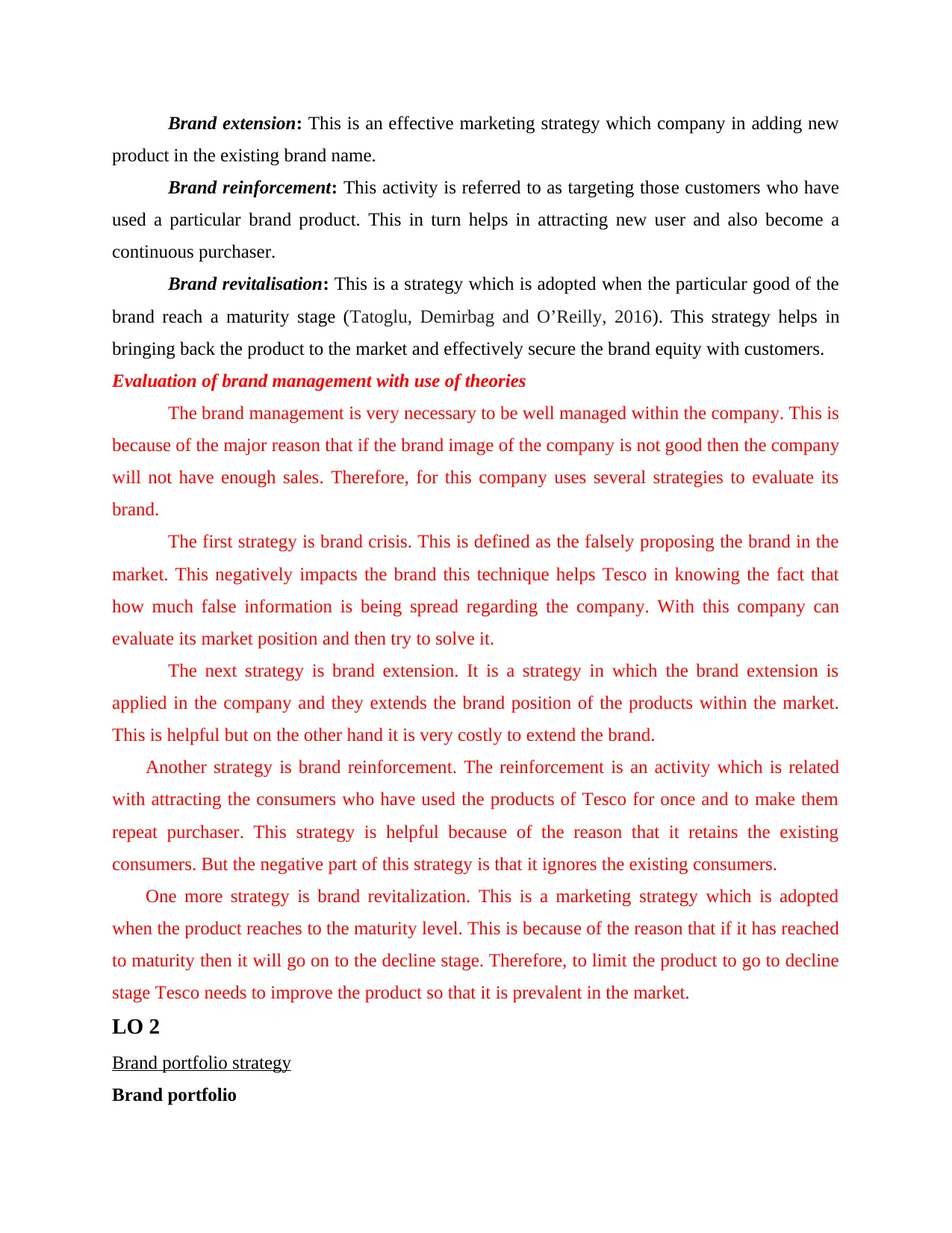
Brand extension: This is an effective marketing strategy which company in adding new
product in the existing brand name.
Brand reinforcement: This activity is referred to as targeting those customers who have
used a particular brand product. This in turn helps in attracting new user and also become a
continuous purchaser.
Brand revitalisation: This is a strategy which is adopted when the particular good of the
brand reach a maturity stage (Tatoglu, Demirbag and O’Reilly, 2016). This strategy helps in
bringing back the product to the market and effectively secure the brand equity with customers.
Evaluation of brand management with use of theories
The brand management is very necessary to be well managed within the company. This is
because of the major reason that if the brand image of the company is not good then the company
will not have enough sales. Therefore, for this company uses several strategies to evaluate its
brand.
The first strategy is brand crisis. This is defined as the falsely proposing the brand in the
market. This negatively impacts the brand this technique helps Tesco in knowing the fact that
how much false information is being spread regarding the company. With this company can
evaluate its market position and then try to solve it.
The next strategy is brand extension. It is a strategy in which the brand extension is
applied in the company and they extends the brand position of the products within the market.
This is helpful but on the other hand it is very costly to extend the brand.
Another strategy is brand reinforcement. The reinforcement is an activity which is related
with attracting the consumers who have used the products of Tesco for once and to make them
repeat purchaser. This strategy is helpful because of the reason that it retains the existing
consumers. But the negative part of this strategy is that it ignores the existing consumers.
One more strategy is brand revitalization. This is a marketing strategy which is adopted
when the product reaches to the maturity level. This is because of the reason that if it has reached
to maturity then it will go on to the decline stage. Therefore, to limit the product to go to decline
stage Tesco needs to improve the product so that it is prevalent in the market.
LO 2
Brand portfolio strategy
Brand portfolio
product in the existing brand name.
Brand reinforcement: This activity is referred to as targeting those customers who have
used a particular brand product. This in turn helps in attracting new user and also become a
continuous purchaser.
Brand revitalisation: This is a strategy which is adopted when the particular good of the
brand reach a maturity stage (Tatoglu, Demirbag and O’Reilly, 2016). This strategy helps in
bringing back the product to the market and effectively secure the brand equity with customers.
Evaluation of brand management with use of theories
The brand management is very necessary to be well managed within the company. This is
because of the major reason that if the brand image of the company is not good then the company
will not have enough sales. Therefore, for this company uses several strategies to evaluate its
brand.
The first strategy is brand crisis. This is defined as the falsely proposing the brand in the
market. This negatively impacts the brand this technique helps Tesco in knowing the fact that
how much false information is being spread regarding the company. With this company can
evaluate its market position and then try to solve it.
The next strategy is brand extension. It is a strategy in which the brand extension is
applied in the company and they extends the brand position of the products within the market.
This is helpful but on the other hand it is very costly to extend the brand.
Another strategy is brand reinforcement. The reinforcement is an activity which is related
with attracting the consumers who have used the products of Tesco for once and to make them
repeat purchaser. This strategy is helpful because of the reason that it retains the existing
consumers. But the negative part of this strategy is that it ignores the existing consumers.
One more strategy is brand revitalization. This is a marketing strategy which is adopted
when the product reaches to the maturity level. This is because of the reason that if it has reached
to maturity then it will go on to the decline stage. Therefore, to limit the product to go to decline
stage Tesco needs to improve the product so that it is prevalent in the market.
LO 2
Brand portfolio strategy
Brand portfolio
Paraphrase This Document
Need a fresh take? Get an instant paraphrase of this document with our AI Paraphraser
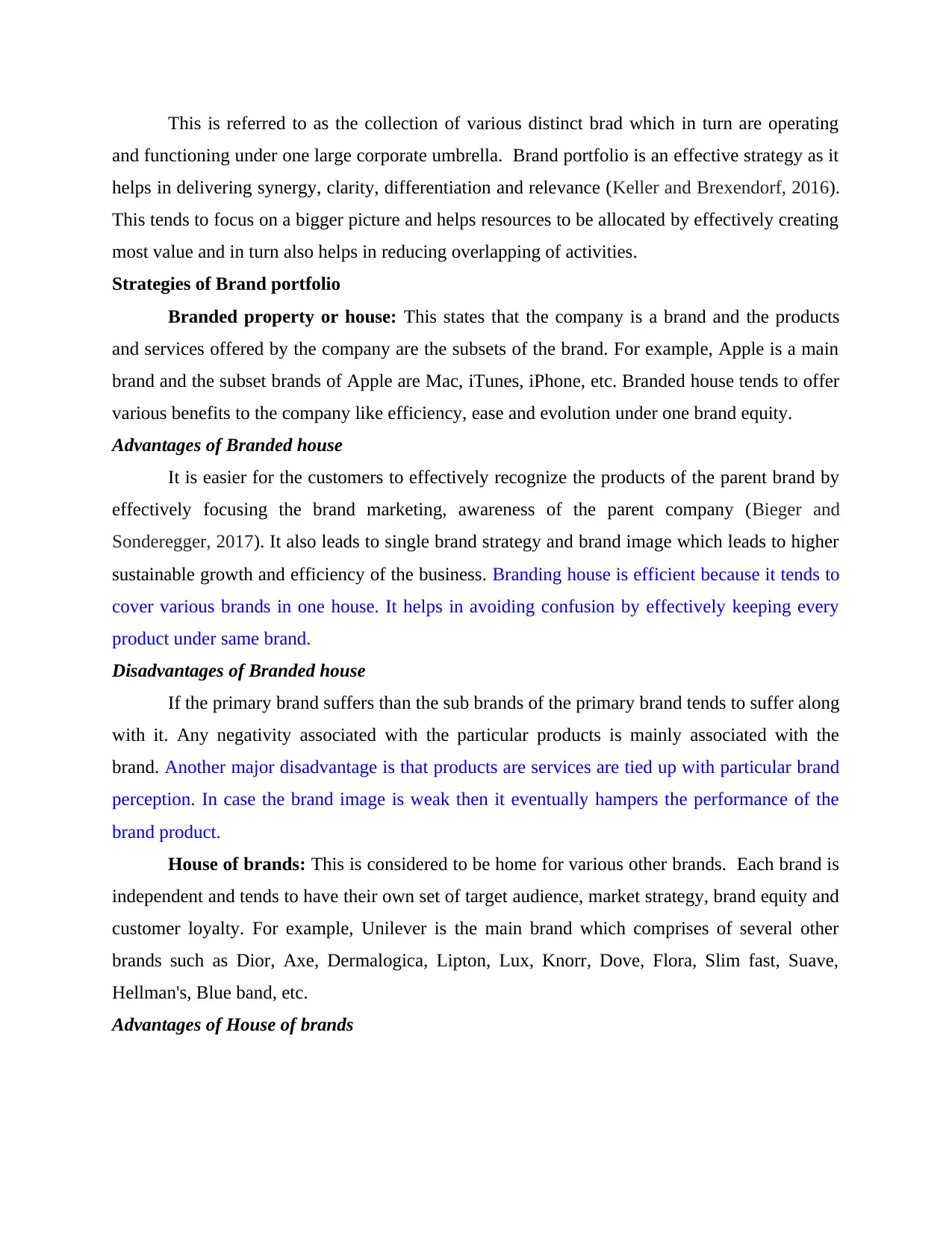
This is referred to as the collection of various distinct brad which in turn are operating
and functioning under one large corporate umbrella. Brand portfolio is an effective strategy as it
helps in delivering synergy, clarity, differentiation and relevance (Keller and Brexendorf, 2016).
This tends to focus on a bigger picture and helps resources to be allocated by effectively creating
most value and in turn also helps in reducing overlapping of activities.
Strategies of Brand portfolio
Branded property or house: This states that the company is a brand and the products
and services offered by the company are the subsets of the brand. For example, Apple is a main
brand and the subset brands of Apple are Mac, iTunes, iPhone, etc. Branded house tends to offer
various benefits to the company like efficiency, ease and evolution under one brand equity.
Advantages of Branded house
It is easier for the customers to effectively recognize the products of the parent brand by
effectively focusing the brand marketing, awareness of the parent company (Bieger and
Sonderegger, 2017). It also leads to single brand strategy and brand image which leads to higher
sustainable growth and efficiency of the business. Branding house is efficient because it tends to
cover various brands in one house. It helps in avoiding confusion by effectively keeping every
product under same brand.
Disadvantages of Branded house
If the primary brand suffers than the sub brands of the primary brand tends to suffer along
with it. Any negativity associated with the particular products is mainly associated with the
brand. Another major disadvantage is that products are services are tied up with particular brand
perception. In case the brand image is weak then it eventually hampers the performance of the
brand product.
House of brands: This is considered to be home for various other brands. Each brand is
independent and tends to have their own set of target audience, market strategy, brand equity and
customer loyalty. For example, Unilever is the main brand which comprises of several other
brands such as Dior, Axe, Dermalogica, Lipton, Lux, Knorr, Dove, Flora, Slim fast, Suave,
Hellman's, Blue band, etc.
Advantages of House of brands
and functioning under one large corporate umbrella. Brand portfolio is an effective strategy as it
helps in delivering synergy, clarity, differentiation and relevance (Keller and Brexendorf, 2016).
This tends to focus on a bigger picture and helps resources to be allocated by effectively creating
most value and in turn also helps in reducing overlapping of activities.
Strategies of Brand portfolio
Branded property or house: This states that the company is a brand and the products
and services offered by the company are the subsets of the brand. For example, Apple is a main
brand and the subset brands of Apple are Mac, iTunes, iPhone, etc. Branded house tends to offer
various benefits to the company like efficiency, ease and evolution under one brand equity.
Advantages of Branded house
It is easier for the customers to effectively recognize the products of the parent brand by
effectively focusing the brand marketing, awareness of the parent company (Bieger and
Sonderegger, 2017). It also leads to single brand strategy and brand image which leads to higher
sustainable growth and efficiency of the business. Branding house is efficient because it tends to
cover various brands in one house. It helps in avoiding confusion by effectively keeping every
product under same brand.
Disadvantages of Branded house
If the primary brand suffers than the sub brands of the primary brand tends to suffer along
with it. Any negativity associated with the particular products is mainly associated with the
brand. Another major disadvantage is that products are services are tied up with particular brand
perception. In case the brand image is weak then it eventually hampers the performance of the
brand product.
House of brands: This is considered to be home for various other brands. Each brand is
independent and tends to have their own set of target audience, market strategy, brand equity and
customer loyalty. For example, Unilever is the main brand which comprises of several other
brands such as Dior, Axe, Dermalogica, Lipton, Lux, Knorr, Dove, Flora, Slim fast, Suave,
Hellman's, Blue band, etc.
Advantages of House of brands
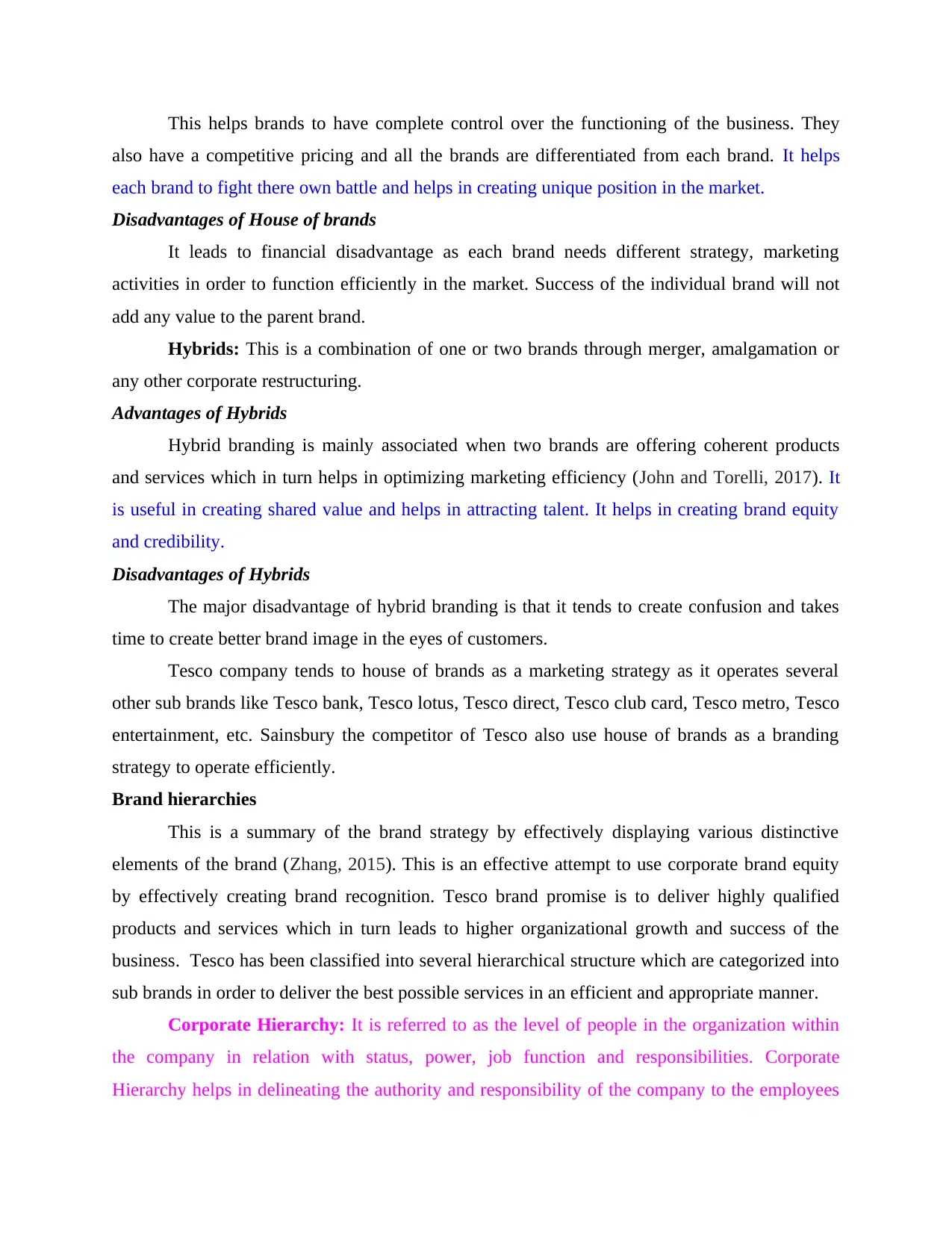
This helps brands to have complete control over the functioning of the business. They
also have a competitive pricing and all the brands are differentiated from each brand. It helps
each brand to fight there own battle and helps in creating unique position in the market.
Disadvantages of House of brands
It leads to financial disadvantage as each brand needs different strategy, marketing
activities in order to function efficiently in the market. Success of the individual brand will not
add any value to the parent brand.
Hybrids: This is a combination of one or two brands through merger, amalgamation or
any other corporate restructuring.
Advantages of Hybrids
Hybrid branding is mainly associated when two brands are offering coherent products
and services which in turn helps in optimizing marketing efficiency (John and Torelli, 2017). It
is useful in creating shared value and helps in attracting talent. It helps in creating brand equity
and credibility.
Disadvantages of Hybrids
The major disadvantage of hybrid branding is that it tends to create confusion and takes
time to create better brand image in the eyes of customers.
Tesco company tends to house of brands as a marketing strategy as it operates several
other sub brands like Tesco bank, Tesco lotus, Tesco direct, Tesco club card, Tesco metro, Tesco
entertainment, etc. Sainsbury the competitor of Tesco also use house of brands as a branding
strategy to operate efficiently.
Brand hierarchies
This is a summary of the brand strategy by effectively displaying various distinctive
elements of the brand (Zhang, 2015). This is an effective attempt to use corporate brand equity
by effectively creating brand recognition. Tesco brand promise is to deliver highly qualified
products and services which in turn leads to higher organizational growth and success of the
business. Tesco has been classified into several hierarchical structure which are categorized into
sub brands in order to deliver the best possible services in an efficient and appropriate manner.
Corporate Hierarchy: It is referred to as the level of people in the organization within
the company in relation with status, power, job function and responsibilities. Corporate
Hierarchy helps in delineating the authority and responsibility of the company to the employees
also have a competitive pricing and all the brands are differentiated from each brand. It helps
each brand to fight there own battle and helps in creating unique position in the market.
Disadvantages of House of brands
It leads to financial disadvantage as each brand needs different strategy, marketing
activities in order to function efficiently in the market. Success of the individual brand will not
add any value to the parent brand.
Hybrids: This is a combination of one or two brands through merger, amalgamation or
any other corporate restructuring.
Advantages of Hybrids
Hybrid branding is mainly associated when two brands are offering coherent products
and services which in turn helps in optimizing marketing efficiency (John and Torelli, 2017). It
is useful in creating shared value and helps in attracting talent. It helps in creating brand equity
and credibility.
Disadvantages of Hybrids
The major disadvantage of hybrid branding is that it tends to create confusion and takes
time to create better brand image in the eyes of customers.
Tesco company tends to house of brands as a marketing strategy as it operates several
other sub brands like Tesco bank, Tesco lotus, Tesco direct, Tesco club card, Tesco metro, Tesco
entertainment, etc. Sainsbury the competitor of Tesco also use house of brands as a branding
strategy to operate efficiently.
Brand hierarchies
This is a summary of the brand strategy by effectively displaying various distinctive
elements of the brand (Zhang, 2015). This is an effective attempt to use corporate brand equity
by effectively creating brand recognition. Tesco brand promise is to deliver highly qualified
products and services which in turn leads to higher organizational growth and success of the
business. Tesco has been classified into several hierarchical structure which are categorized into
sub brands in order to deliver the best possible services in an efficient and appropriate manner.
Corporate Hierarchy: It is referred to as the level of people in the organization within
the company in relation with status, power, job function and responsibilities. Corporate
Hierarchy helps in delineating the authority and responsibility of the company to the employees
⊘ This is a preview!⊘
Do you want full access?
Subscribe today to unlock all pages.

Trusted by 1+ million students worldwide
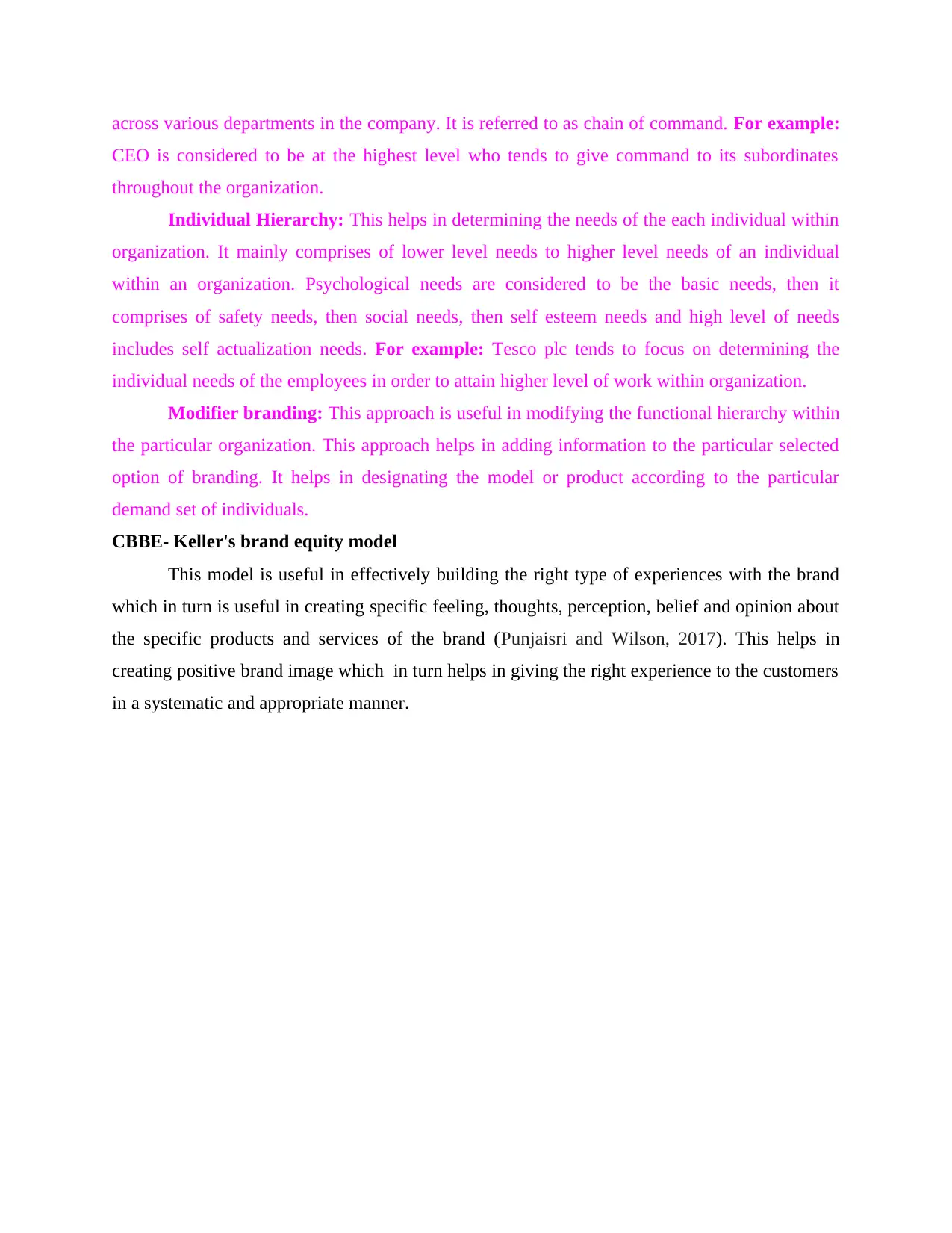
across various departments in the company. It is referred to as chain of command. For example:
CEO is considered to be at the highest level who tends to give command to its subordinates
throughout the organization.
Individual Hierarchy: This helps in determining the needs of the each individual within
organization. It mainly comprises of lower level needs to higher level needs of an individual
within an organization. Psychological needs are considered to be the basic needs, then it
comprises of safety needs, then social needs, then self esteem needs and high level of needs
includes self actualization needs. For example: Tesco plc tends to focus on determining the
individual needs of the employees in order to attain higher level of work within organization.
Modifier branding: This approach is useful in modifying the functional hierarchy within
the particular organization. This approach helps in adding information to the particular selected
option of branding. It helps in designating the model or product according to the particular
demand set of individuals.
CBBE- Keller's brand equity model
This model is useful in effectively building the right type of experiences with the brand
which in turn is useful in creating specific feeling, thoughts, perception, belief and opinion about
the specific products and services of the brand (Punjaisri and Wilson, 2017). This helps in
creating positive brand image which in turn helps in giving the right experience to the customers
in a systematic and appropriate manner.
CEO is considered to be at the highest level who tends to give command to its subordinates
throughout the organization.
Individual Hierarchy: This helps in determining the needs of the each individual within
organization. It mainly comprises of lower level needs to higher level needs of an individual
within an organization. Psychological needs are considered to be the basic needs, then it
comprises of safety needs, then social needs, then self esteem needs and high level of needs
includes self actualization needs. For example: Tesco plc tends to focus on determining the
individual needs of the employees in order to attain higher level of work within organization.
Modifier branding: This approach is useful in modifying the functional hierarchy within
the particular organization. This approach helps in adding information to the particular selected
option of branding. It helps in designating the model or product according to the particular
demand set of individuals.
CBBE- Keller's brand equity model
This model is useful in effectively building the right type of experiences with the brand
which in turn is useful in creating specific feeling, thoughts, perception, belief and opinion about
the specific products and services of the brand (Punjaisri and Wilson, 2017). This helps in
creating positive brand image which in turn helps in giving the right experience to the customers
in a systematic and appropriate manner.
Paraphrase This Document
Need a fresh take? Get an instant paraphrase of this document with our AI Paraphraser
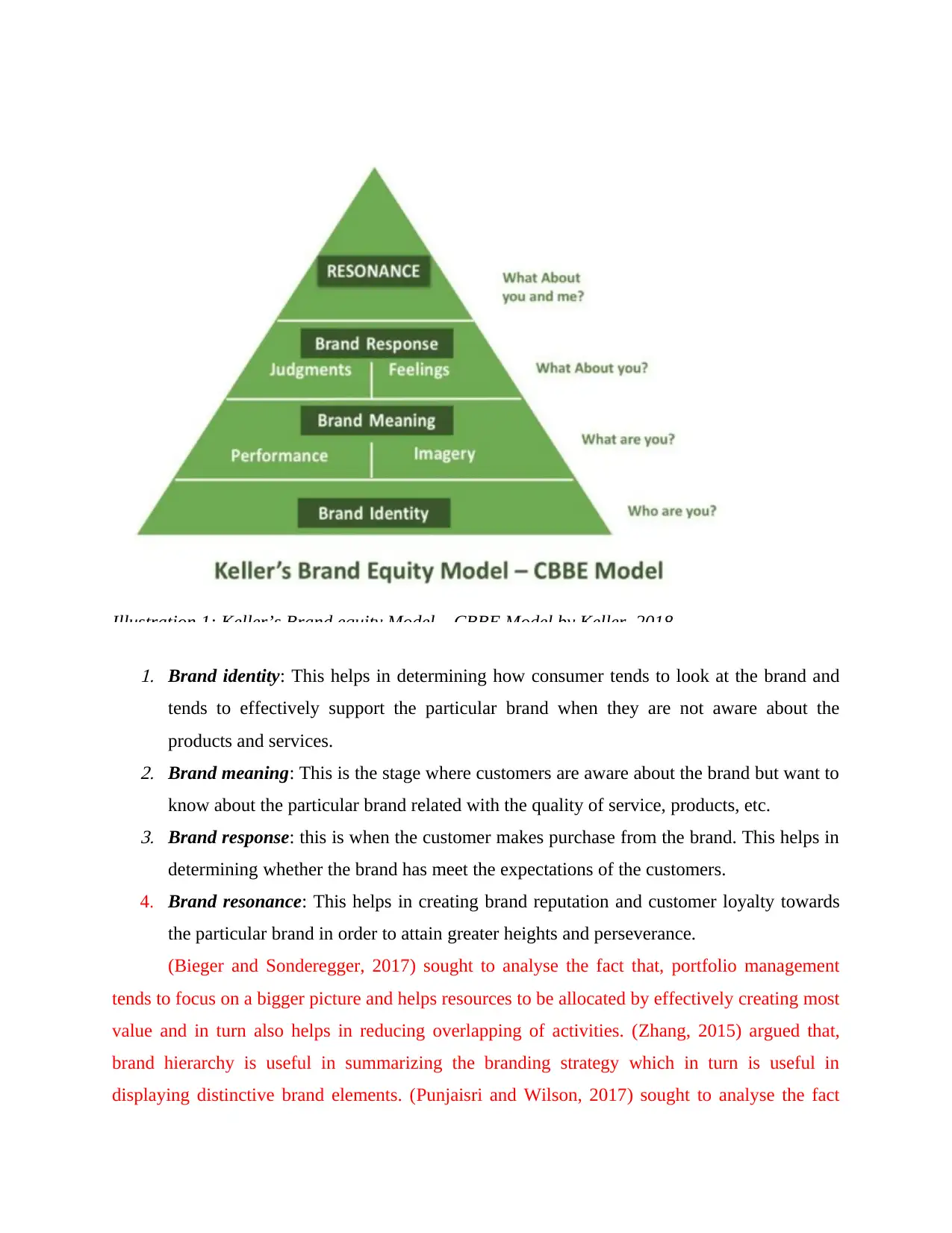
Illustration 1: Keller’s Brand equity Model – CBBE Model by Keller, 2018
1. Brand identity: This helps in determining how consumer tends to look at the brand and
tends to effectively support the particular brand when they are not aware about the
products and services.2. Brand meaning: This is the stage where customers are aware about the brand but want to
know about the particular brand related with the quality of service, products, etc.3. Brand response: this is when the customer makes purchase from the brand. This helps in
determining whether the brand has meet the expectations of the customers.
4. Brand resonance: This helps in creating brand reputation and customer loyalty towards
the particular brand in order to attain greater heights and perseverance.
(Bieger and Sonderegger, 2017) sought to analyse the fact that, portfolio management
tends to focus on a bigger picture and helps resources to be allocated by effectively creating most
value and in turn also helps in reducing overlapping of activities. (Zhang, 2015) argued that,
brand hierarchy is useful in summarizing the branding strategy which in turn is useful in
displaying distinctive brand elements. (Punjaisri and Wilson, 2017) sought to analyse the fact
1. Brand identity: This helps in determining how consumer tends to look at the brand and
tends to effectively support the particular brand when they are not aware about the
products and services.2. Brand meaning: This is the stage where customers are aware about the brand but want to
know about the particular brand related with the quality of service, products, etc.3. Brand response: this is when the customer makes purchase from the brand. This helps in
determining whether the brand has meet the expectations of the customers.
4. Brand resonance: This helps in creating brand reputation and customer loyalty towards
the particular brand in order to attain greater heights and perseverance.
(Bieger and Sonderegger, 2017) sought to analyse the fact that, portfolio management
tends to focus on a bigger picture and helps resources to be allocated by effectively creating most
value and in turn also helps in reducing overlapping of activities. (Zhang, 2015) argued that,
brand hierarchy is useful in summarizing the branding strategy which in turn is useful in
displaying distinctive brand elements. (Punjaisri and Wilson, 2017) sought to analyse the fact
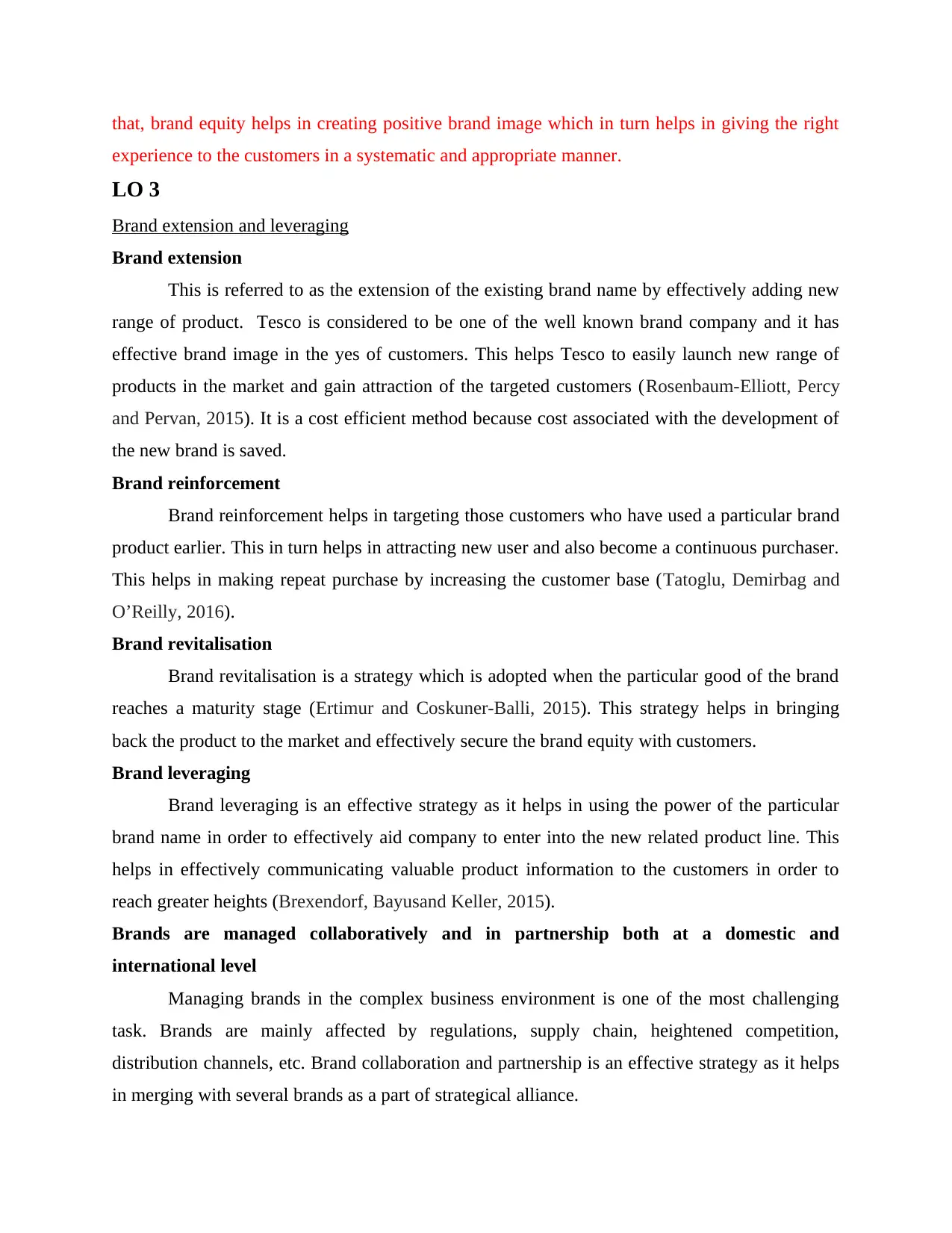
that, brand equity helps in creating positive brand image which in turn helps in giving the right
experience to the customers in a systematic and appropriate manner.
LO 3
Brand extension and leveraging
Brand extension
This is referred to as the extension of the existing brand name by effectively adding new
range of product. Tesco is considered to be one of the well known brand company and it has
effective brand image in the yes of customers. This helps Tesco to easily launch new range of
products in the market and gain attraction of the targeted customers (Rosenbaum-Elliott, Percy
and Pervan, 2015). It is a cost efficient method because cost associated with the development of
the new brand is saved.
Brand reinforcement
Brand reinforcement helps in targeting those customers who have used a particular brand
product earlier. This in turn helps in attracting new user and also become a continuous purchaser.
This helps in making repeat purchase by increasing the customer base (Tatoglu, Demirbag and
O’Reilly, 2016).
Brand revitalisation
Brand revitalisation is a strategy which is adopted when the particular good of the brand
reaches a maturity stage (Ertimur and Coskuner-Balli, 2015). This strategy helps in bringing
back the product to the market and effectively secure the brand equity with customers.
Brand leveraging
Brand leveraging is an effective strategy as it helps in using the power of the particular
brand name in order to effectively aid company to enter into the new related product line. This
helps in effectively communicating valuable product information to the customers in order to
reach greater heights (Brexendorf, Bayusand Keller, 2015).
Brands are managed collaboratively and in partnership both at a domestic and
international level
Managing brands in the complex business environment is one of the most challenging
task. Brands are mainly affected by regulations, supply chain, heightened competition,
distribution channels, etc. Brand collaboration and partnership is an effective strategy as it helps
in merging with several brands as a part of strategical alliance.
experience to the customers in a systematic and appropriate manner.
LO 3
Brand extension and leveraging
Brand extension
This is referred to as the extension of the existing brand name by effectively adding new
range of product. Tesco is considered to be one of the well known brand company and it has
effective brand image in the yes of customers. This helps Tesco to easily launch new range of
products in the market and gain attraction of the targeted customers (Rosenbaum-Elliott, Percy
and Pervan, 2015). It is a cost efficient method because cost associated with the development of
the new brand is saved.
Brand reinforcement
Brand reinforcement helps in targeting those customers who have used a particular brand
product earlier. This in turn helps in attracting new user and also become a continuous purchaser.
This helps in making repeat purchase by increasing the customer base (Tatoglu, Demirbag and
O’Reilly, 2016).
Brand revitalisation
Brand revitalisation is a strategy which is adopted when the particular good of the brand
reaches a maturity stage (Ertimur and Coskuner-Balli, 2015). This strategy helps in bringing
back the product to the market and effectively secure the brand equity with customers.
Brand leveraging
Brand leveraging is an effective strategy as it helps in using the power of the particular
brand name in order to effectively aid company to enter into the new related product line. This
helps in effectively communicating valuable product information to the customers in order to
reach greater heights (Brexendorf, Bayusand Keller, 2015).
Brands are managed collaboratively and in partnership both at a domestic and
international level
Managing brands in the complex business environment is one of the most challenging
task. Brands are mainly affected by regulations, supply chain, heightened competition,
distribution channels, etc. Brand collaboration and partnership is an effective strategy as it helps
in merging with several brands as a part of strategical alliance.
⊘ This is a preview!⊘
Do you want full access?
Subscribe today to unlock all pages.

Trusted by 1+ million students worldwide
1 out of 21
Related Documents
Your All-in-One AI-Powered Toolkit for Academic Success.
+13062052269
info@desklib.com
Available 24*7 on WhatsApp / Email
![[object Object]](/_next/static/media/star-bottom.7253800d.svg)
Unlock your academic potential
Copyright © 2020–2025 A2Z Services. All Rights Reserved. Developed and managed by ZUCOL.

